- JPMorgan is predicting a lackluster 2024 for the S&P 500, forecasting an 8% drop to 4,200 by year-end due to slowing growth and tightening financial conditions.
- JPMorgan’s gloomy outlook contrasts sharply with more upbeat 2024 forecasts from other major banks predicting new highs above 5,000 for the S&P 500.
- JPMorgan sees risks from slowing consumer spending, rising rates, lingering geopolitical tensions, and volatility from national elections weighing on stocks in 2024.
JPMorgan Chase is predicting a lackluster 2024 for the stock market, breaking from the optimism of many Wall Street strategists who are calling for new highs. The bank sees the S&P 500 Index dropping 8% by the end of 2024 due to slowing growth and other headwinds.
JPMorgan’s Bearish Forecast
The S&P 500 will fall to 4,200 points by end of 2024 according to JPMorgan’s chief global equity strategist. This view reiterates the bank’s downbeat outlook for 2023 that has so far missed the mark as stocks surge nearly 19% this year amid economic resilience. JPMorgan cites slowing consumer spending, tightening financial conditions, and lingering geopolitical risks as drags on stocks.
Contrast With More Upbeat Strategists
JPMorgan’s dreary forecast contrasts sharply with growing calls on Wall Street for the S&P 500 to reach new records above 5,000 in 2024. Banks like BofA and Deutsche Bank see robust gains, while even former bears like Morgan Stanley are now more constructive on stocks. JPMorgan’s 4,200 target is the lowest among major banks.
Rationale for Caution
The bank sees consensus growth estimates as too optimistic given prospects for higher interest rates. While not as dire as 2022, JPMorgan likens 2024 to a “less pessimistic” view. The firm expects mild 2-3% earnings growth next year and sees risks from national elections causing volatility. Absent rapid Fed easing, JPMorgan expects headwinds for stocks.
Conclusion
Despite the stock market’s strong gains in 2023, JPMorgan remains stubbornly bearish in its outlook. The bank is an outlier in predicting lackluster returns in 2024, breaking from the upbeat calls of competitors forecasting new highs. Time will tell whether the cautious view proves prescient as growth slows.














